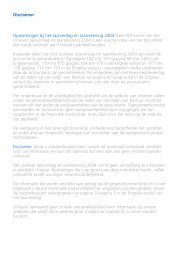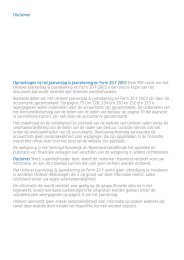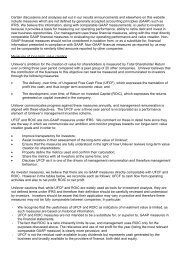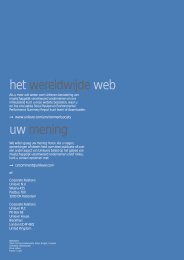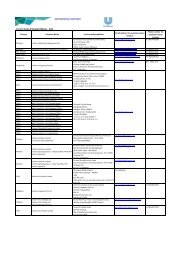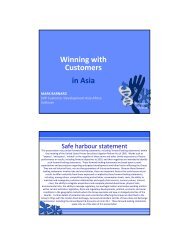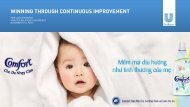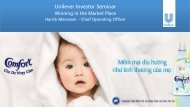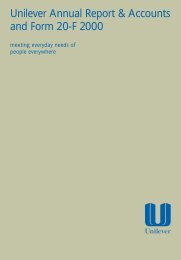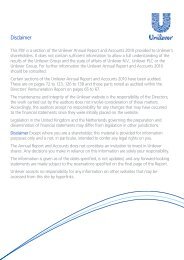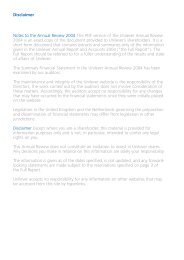Unilever Sustainable Living Plan Progress Report 2011
Unilever Sustainable Living Plan Progress Report 2011
Unilever Sustainable Living Plan Progress Report 2011
You also want an ePaper? Increase the reach of your titles
YUMPU automatically turns print PDFs into web optimized ePapers that Google loves.
22 <strong>Unilever</strong> <strong>Sustainable</strong> <strong>Living</strong> <strong>Plan</strong> <strong>Progress</strong> <strong>Report</strong> <strong>2011</strong><br />
4.0<br />
OUR COMMITMENT<br />
oUr aPProach<br />
Water is a basic human need. The United nations estimates<br />
that each person needs 20–50 litres per day for drinking and<br />
daily tasks like cooking and washing.<br />
The average north American uses 550 litres daily, while in<br />
the poorest countries people live on as little as 10 litres a<br />
day. Worldwide, some 70% of total water consumption is<br />
used for agriculture.<br />
Water shortages are increasingly common and already touch<br />
many parts of the world, from china to India to the United<br />
States. Their growing frequency is the result of population<br />
growth, improving incomes and climate change. The amount<br />
of water available per head of population has halved over the<br />
last 30 years and is predicted to halve again in the next ten.<br />
It is estimated that the world will face a 40% global shortfall<br />
between demand and supply by 2030.<br />
our products rely on water at all stages of their lifecycle.<br />
To grow our business sustainably, we must reduce the<br />
total amount of water used across our value chain. our<br />
<strong>Sustainable</strong> Agriculture Programme helps farmers reduce<br />
their water use. We are reducing the water used in our<br />
manufacturing processes. And we can make a big difference<br />
by designing products which require less water in the home.<br />
We are making some progress. our comfort one Rinse<br />
fabric conditioner reduces the water needed for rinsing<br />
clothes from three buckets to one. We have also learnt more<br />
about current showering and bathing habits which will help<br />
us develop new product solutions. But transformational<br />
change will only come when water is priced and there is a<br />
financial incentive to encourage new behaviours.<br />
Halve the water associated with the consumer use of our products by 2020.*<br />
OUR PERFORMANCE<br />
Given the complexity of calculating the impacts of our<br />
product portfolio, we are investing in an automated<br />
process to allow us to measure progress regularly.<br />
An interim sample of 2010 data shows that our water<br />
footprint has remained broadly unchanged.<br />
OUR FOOTPRINT<br />
Source for Footprint and pie charts: <strong>Unilever</strong> 2008 baseline study across seven<br />
water-scarce countries (see page 41). Total in litres.<br />
WHAT MATTERS MOST<br />
Reducing water use when doing laundry,<br />
showering and washing hair.<br />
[50%] EStiMAtE



